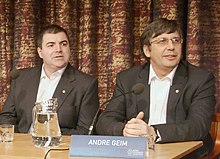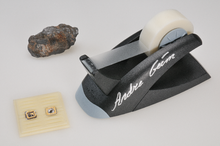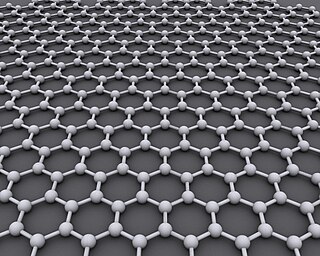
Graphene is an allotrope of carbon consisting of a single layer of atoms arranged in a hexagonal lattice nanostructure. The name is derived from "graphite" and the suffix -ene, reflecting the fact that the graphite allotrope of carbon contains numerous double bonds.
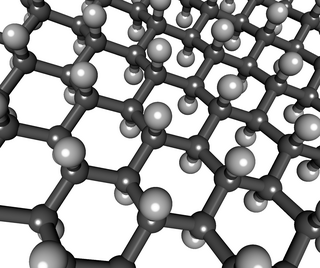
Graphane is a two-dimensional polymer of carbon and hydrogen with the formula unit (CH)n where n is large. Partial hydrogenation results in hydrogenated graphene, which was reported by Elias et al. in 2009 by a TEM study to be "direct evidence for a new graphene-based derivative". The authors viewed the panorama as "a whole range of new two-dimensional crystals with designed electronic and other properties".
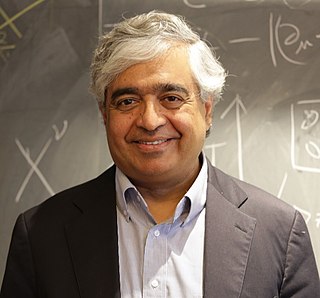
Subir Sachdev is Herchel Smith Professor of Physics at Harvard University specializing in condensed matter. He was elected to the U.S. National Academy of Sciences in 2014, received the Lars Onsager Prize from the American Physical Society and the Dirac Medal from the ICTP in 2018, and was elected Foreign Member of the Royal Society ForMemRS in 2023. He was a co-editor of the Annual Review of Condensed Matter Physics 2017–2019, and is Editor-in-Chief of Reports on Progress in Physics 2022-.

A topological insulator is a material whose interior behaves as an electrical insulator while its surface behaves as an electrical conductor, meaning that electrons can only move along the surface of the material.
Katsunori Wakabayashi is a physicist at the International Center for Materials Nanoarchitectonics (MANA), National Institute for Materials Science (NIMS), Japan. He is an authority and leading researcher in nanotechnology in the area of energy states of single wall carbon nanotubes (SWCN). His research is notable for the edge effects of the nanographene materials, which is a part of the single layer graphene. He obtained his Ph.D. in 2000 from University of Tsukuba in Japan. From 2000 to 2009 he was an assistant professor at Department of Quantum Matter in Hiroshima University, Japan. From 2009, he is an Independent Scientist at International Center for Materials Nanoarchitectonics (WPI-MANA), National Institute for Materials Science (NIMS) in Tsukuba, Japan. Beside the above primary research position, he was a visiting scholar at ETH-Zurich, Switzerland from 2003 to 2005, also had a concurrent position as PRESTO researcher in Japan Science and Technology Agency (JST).

Walter Alexander "Walt" de Heer is a Dutch physicist and nanoscience researcher known for discoveries in the electronic shell structure of metal clusters, magnetism in transition metal clusters, field emission and ballistic conduction in carbon nanotubes, and graphene-based electronics.
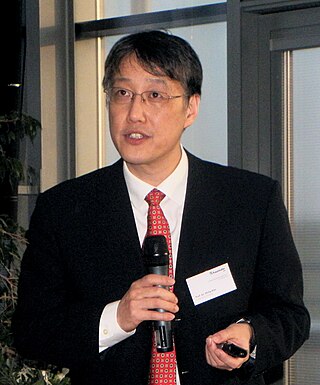
Philip Kim is a South Korean physicist. He is a condensed matter physicist known for study of quantum transport in carbon nanotubes and graphene, including observations of quantum Hall effects in graphene.

Sir Konstantin Sergeevich Novoselov is a Russian–British physicist. His work on graphene with Andre Geim earned them the Nobel Prize in Physics in 2010. Novoselov is a professor at the Centre for Advanced 2D Materials, National University of Singapore and is also the Langworthy Professor of the School of Physics and Astronomy at the University of Manchester.
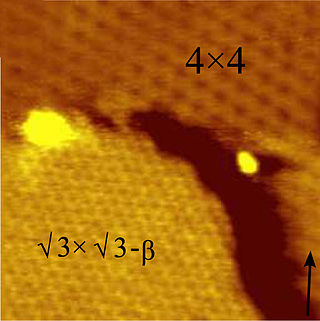
Silicene is a two-dimensional allotrope of silicon, with a hexagonal honeycomb structure similar to that of graphene. Contrary to graphene, silicene is not flat, but has a periodically buckled topology; the coupling between layers in silicene is much stronger than in multilayered graphene; and the oxidized form of silicene, 2D silica, has a very different chemical structure from graphene oxide.
Bilayer graphene is a material consisting of two layers of graphene. One of the first reports of bilayer graphene was in the seminal 2004 Science paper by Geim and colleagues, in which they described devices "which contained just one, two, or three atomic layers"
Valleytronics is an experimental area in semiconductors that exploits local extrema ("valleys") in the electronic band structure. Certain semiconductors have multiple "valleys" in the electronic band structure of the first Brillouin zone, and are known as multivalley semiconductors. Valleytronics is the technology of control over the valley degree of freedom, a local maximum/minimum on the valence/conduction band, of such multivalley semiconductors.
A two-dimensional semiconductor is a type of natural semiconductor with thicknesses on the atomic scale. Geim and Novoselov et al. initiated the field in 2004 when they reported a new semiconducting material graphene, a flat monolayer of carbon atoms arranged in a 2D honeycomb lattice. A 2D monolayer semiconductor is significant because it exhibits stronger piezoelectric coupling than traditionally employed bulk forms. This coupling could enable applications. One research focus is on designing nanoelectronic components by the use of graphene as electrical conductor, hexagonal boron nitride as electrical insulator, and a transition metal dichalcogenide as semiconductor.
A rapidly increasing list of graphene production techniques have been developed to enable graphene's use in commercial applications.

In physics, Dirac cones are features that occur in some electronic band structures that describe unusual electron transport properties of materials like graphene and topological insulators. In these materials, at energies near the Fermi level, the valence band and conduction band take the shape of the upper and lower halves of a conical surface, meeting at what are called Dirac points.
Eva Yocheved Andrei is an American condensed matter physicist, a Distinguished Professor, and a Board of Governors Professor at Rutgers University. Her research focuses on emergent properties of matter arising from the collective behavior of many particles, especially low-dimensional phenomena under low temperatures and high magnetic fields.
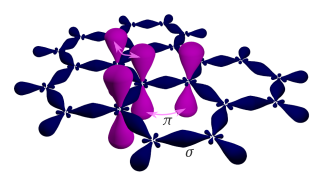
Graphene is a semimetal whose conduction and valence bands meet at the Dirac points, which are six locations in momentum space, the vertices of its hexagonal Brillouin zone, divided into two non-equivalent sets of three points. The two sets are labeled K and K'. The sets give graphene a valley degeneracy of gv = 2. By contrast, for traditional semiconductors the primary point of interest is generally Γ, where momentum is zero. Four electronic properties separate it from other condensed matter systems.
The term Dirac matter refers to a class of condensed matter systems which can be effectively described by the Dirac equation. Even though the Dirac equation itself was formulated for fermions, the quasi-particles present within Dirac matter can be of any statistics. As a consequence, Dirac matter can be distinguished in fermionic, bosonic or anyonic Dirac matter. Prominent examples of Dirac matter are graphene and other Dirac semimetals, topological insulators, Weyl semimetals, various high-temperature superconductors with -wave pairing and liquid helium-3. The effective theory of such systems is classified by a specific choice of the Dirac mass, the Dirac velocity, the gamma matrices and the space-time curvature. The universal treatment of the class of Dirac matter in terms of an effective theory leads to a common features with respect to the density of states, the heat capacity and impurity scattering.
Epitaxial graphene growth on silicon carbide (SiC) by thermal decomposition is a method to produce large-scale few-layer graphene (FLG). Graphene is one of the most promising nanomaterials for the future because of its various characteristics, like strong stiffness and high electric and thermal conductivity. Still, reproducible production of Graphene is difficult, thus many different techniques have been developed. The main advantage of epitaxial graphene growth on silicon carbide over other techniques is to obtain graphene layers directly on a semiconducting or semi-insulating substrate which is commercially available.

Andrea Carlo Ferrari is a professor of nanotechnology at the University of Cambridge.

Antonio Helio de Castro Neto is a Brazilian-born physicist. He is the founder and director of the Centre for Advanced 2D Materials at the National University of Singapore. He is a condensed matter theorist known for his work in the theory of metals, magnets, superconductors, graphene and two-dimensional materials. He is a distinguished professor in the Departments of Materials Science Engineering, and Physics and a professor at the Department of Electrical and Computer Engineering. He was elected as a fellow of the American Physical Society in 2003. In 2011 he was elected as a fellow of the American Association for the Advancement of Science.
